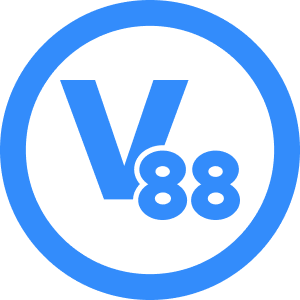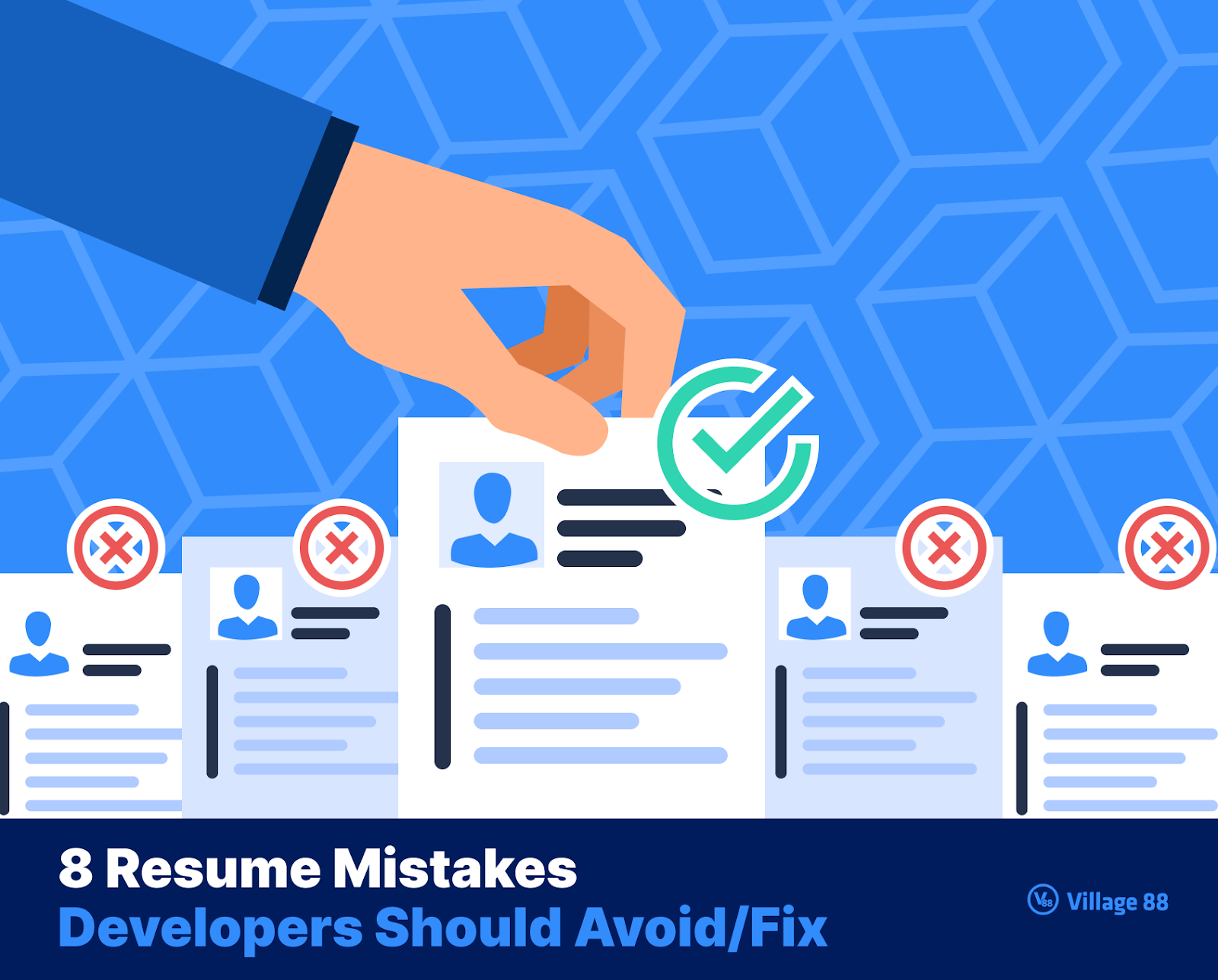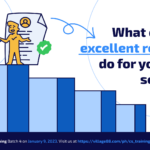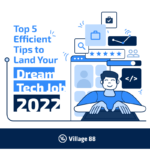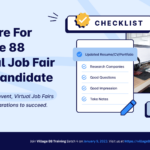A famous quote says the journey of a thousand miles begins with a single step. For developers journeying to land their dream job, they start with the crucial step of making their resumes as flawless as possible.
It’s no secret that hiring managers scan through resumes for about six to seven seconds, then cast aside resumes that do not meet their standards. As a software engineer, you know you have the skills to get the positions you saw in the job ads you’ve been applying for, but you haven’t heard back from any of them.
Maybe it’s time to ask yourself if your resume is written excellently enough to get yourself to the initial phone interview.
If this is your first time writing a resume or you think that your resume isn’t working the way you want, check out if you’ve made any of these frequently seen mistakes in writing resumes.
1. Poor Layout and Formatting
How your resume looks is as important as what’s in it. The very first thing any recruiter will notice in a resume is the layout and formatting. Recruiters scan through hundreds of resumes weekly, and they wouldn’t want to review a visually too busy resume.
If you want prospective employers to read the contents of your resume, make sure to invest time and effort into making it look good.
DON’Ts
- Edge-to-edge texts.
- Inconsistent fonts and font sizes.
- Different styles of bullet points.
- Too much bolding and underlines.
- No uniform alignment and spacing.
DOs
- Use the same font throughout your resume, preferably Calibri or Verdana, as they look fresher to the eyes compared to using Times New Roman.
- Use bullet points to highlight skills and accomplishments.
- Use bolding details sparingly.
- Be consistent with the alignment and spacing.
- Create one-inch margins and apply the same line and paragraph spacing
2. Typos and other Grammatical Errors
This mistake may seem obvious, and yes, it is. Remember, your resume sells you to your prospective employer. Recruiters might read between the lines and make some not-so-favorable conclusions like: you’re an unprofessional, lazy, or poor communicator.
DON’Ts
- Spelling mistakes.
- Wrong use of prepositions.
- Using there/their/they’re incorrectly.
- Interchanging the use of your and you’re.
- Adding apostrophes even when not needed.
DOs
- Use a typing assistant application or software to review spelling, grammar, clarity, punctuation, engagement, delivery mistakes, etc.
- Ask a family member or friend to review your resume to give you feedback.
3. One-Size-Fits-All Approach
Today, one-size-fits-all resumes no longer work. They are too general, generic, and often vague. Tailor your resume to the position to stand out from the sea of applications.
Not tailoring your resume to the position you are applying for sends all the wrong signals to recruiters and shows a lack of effort and interest. This type of resume shows the “any-job-will-do” mindset of an applicant. You wouldn’t want hiring managers to think that of you.
DON’Ts
- Detailing all your skills, including maybe plumbing and cross-stitching.
- Generic resume template patterned after online sample.
- Lacks the buzzwords listed in the job posting.
DOs
- Take time to study the job listing posted and tailor your resume according to the requirements the company is looking for.
- Highlight the technical and soft skills you have that fit the bill.
- Make sure to use the buzzwords used in the job posting in the three major sections of your resume: profile summary, core competencies or strengths, and work experience.
4. Going Too Long or Cutting Things Too Short on Work Experience
This section might sound confusing but hear us out. Many applicants squeeze in too much information on one page, forcing them to leave out impressive work experiences. Others ramble on about unnecessary or irrelevant experiences.
The general rule of thumb is resumes shouldn’t go beyond two pages. When writing your resume, ask yourself if that work experience will sell you and land you an interview, if not, don’t put it in.
DON’Ts
- Not chronologically arranged.
- Work experiences that do not highlight your tech, soft skills, or anything relevant to the position.
- Highlighting only your responsibilities.
DOs
- Arrange your work experience chronologically to make it easier to digest and will be more relevant to the reader.
- Don’t go writing a book to explain all your technical experiences. Keep things brief and straightforward.
- Include details and experiences relevant to the position you are applying for and make sure they fit the job description.
- Use action verbs. Discuss your significant achievements while doing responsibilities to show how good you are at your job.
Note: If you don’t have prior work experience, you can add your educational background and other training you completed. You can also include your graduation project, thesis, and other training outputs. Discuss what you have accomplished during your college years and training.
5. Use those KEYWORDS
Let’s go into more detail about buzzwords or keywords.
Most recruiters simply scan resumes for relevant experience, so having keywords makes your resume stand out against all other candidates. Using the keywords gets the attention of hiring managers because they match the job description.
Also, keep in mind that some companies pre-scan applications electronically with Applicant Tracking Systems (ATS), which screen specifically for keywords and phrases related to the job.
DON’Ts
- Random keywords not related to the position.
- Write just keywords like Python, PHP, Quality Assurance, six years experience, etc., in your work experience.
DO’s
- Review the skills and experience the job post requires. Research keywords you can use.
- Don’t just write keywords; use them in sentences to describe your skills and what you have accomplished using these skills.
- Include all the top skills requirements you have in the skills section and add a few extras.
- Include the software and hardware you have experienced using. Research and use only the most recognizable terms to keep your resume readable by the ATS.
Notes: If you don’t have work experience, you can include keywords in your educational background and other training experiences.
6. Email Address
You can be as goofy and free-spirited in your personal life as much as you want, but please spare your job search email. Yes, I’m talking to you, Mamas_boy143@email.com.
Your email is one of the professional images that your resume will paint of you, one that recruiters will see. You wouldn’t want recruiters to cringe and think you’re too lazy to create a professional image. Create the right impression and credibility with your email address.
DONT’s
- Using codenames as username or email address.
- Using excessive punctuations like hyphens and periods.
DOs
- Use a simple email address using your real name to make it easy to remember. You can use the first name only, first plus last initial, first initial plus last name, or full name.
- Avoid using numbers as much as possible.
- Go easy on the punctuation; limit underscores and periods to just one.
7. Links
Assuming that you’re sending out your application online, adding links is acceptable.
Software engineers should include links to your LinkedIn profile and the various projects you’ve built. You should be mindful when adding these links.
DON’Ts
- Using the full links and not hyperlinking your links.
- Non-clickable or broken links.
- Links to an outdated LinkedIn profile, empty Github, and other websites.
- Scattered and random links.
DOs
- Hyperlink them. Describe briefly what that link is about and hide them behind the texts. (ctrl + k, then paste)
- Double-check your links to make sure they are clickable and accessible. Send it to a friend to try clicking the links. Recruiters are likely never to copy-paste links included in resumes; they click the link to be redirected.
- Update your LinkedIn profile before adding them to your resume. Make sure that the projects you added to your resume are related to the position you’re applying for and worth the recruiter’s time. Remember to prioritize quality over quantity.
- Keep your project links in one section, and create a project portfolio.
8. Wrong Contact Information
There are a few cases where developers put in the wrong contact number or misspelled their email address, and recruiters couldn’t reach them. Who would put in the incorrect contact details? Sounds stupid, right? Yes, it can happen, especially when you’re too excited or nervous while writing your resume.
DON’Ts
- Never double-check contact information.
DOs
- Check your contact info twice or thrice. Or send it to a friend and ask them to send you an email or text using the contact information you provided.
Even your resume’s most minute and taken-for-granted details may cost you your dream job. Avoid or fix these mistakes, assess your current resume and check if you made any of these mistakes. Learn from these mistakes and make your first step to landing your dream job a strong one.
Be JOB-READY and add more KEYWORDS to your resume
Village 88 conducts two seasons of Free Online Training Program every year. Everyone with a coding background is welcome to join, whether you’re a CS/IT OJT student, a fresh CS/IT graduate, a career shifter, or just want to go back to coding.
Be equipped with the latest software development technologies that match the current need of the IT industry. Join our 20-week intensive training with 1-week resume assistance.
Our second training season is coming up! Registration is open, and training starts on July 04, 2022.
To learn more about the training, you can connect and message us on our Facebook page: Village88. We’d love to hear from you!
